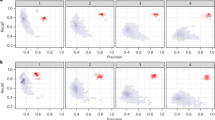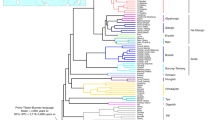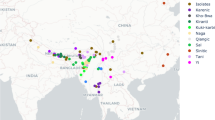Abstract
Most languages of the world are taken to result from a combination of a vertical transmission process from older to younger generations of speakers or signers and (mostly) gradual changes that accumulate over time. In contrast, creole languages emerge within a few generations out of highly multilingual societies in situations where no common first language is available for communication (as, for instance, in plantations related to the Atlantic slave trade). Strikingly, creoles share a number of linguistic features (the ‘creole profile’), which is at odds with the striking linguistic diversity displayed by non-creole languages1,2,3,4. These common features have been explained as reflecting a hardwired default state of the possible grammars that can be learned by humans1, as straightforward solutions to cope with the pressure for efficient and successful communication5 or as the byproduct of an impoverished transmission process6. Despite their differences, these proposals agree that creoles emerge from a very limited and basic communication system (a pidgin) that only later in time develops the characteristics of a natural language, potentially by innovating linguistic structure. Here we analyse 48 creole languages and 111 non-creole languages from all continents and conclude that the similarities (and differences) between creoles can be explained by genealogical and contact processes7,8, as with non-creole languages, with the difference that creoles have more than one language in their ancestry. While a creole profile can be detected statistically, this stems from an over-representation of Western European and West African languages in their context of emergence. Our findings call into question the existence of a pidgin stage in creole development and of creole-specific innovations. In general, given their extreme conditions of emergence, they lend support to the idea that language learning and transmission are remarkably resilient processes.
This is a preview of subscription content, access via your institution
Access options
Access Nature and 54 other Nature Portfolio journals
Get Nature+, our best-value online-access subscription
$29.99 / 30 days
cancel any time
Subscribe to this journal
Receive 12 digital issues and online access to articles
$119.00 per year
only $9.92 per issue
Buy this article
- Purchase on Springer Link
- Instant access to full article PDF
Prices may be subject to local taxes which are calculated during checkout

Similar content being viewed by others
References
Bickerton, D. Roots of Language (Karoma, Ann Arbor, MI, 1981).
McWhorter, J. H. The world’s simplest grammars are creole grammars. Ling. Typol. 5, 125–166 (2001).
Parkvall, M. in Language Complexity: Typology, Contact, Change (eds Miestamo, M., Sinnemäki, K. & Karlsson, F.) 265–285 (Benjamins, Amsterdam, the Netherlands, 2008).
Bakker, P., Daval-Markussen, A., Parkvall, M. & Plag, I. Creoles are typologically distinct from non-creoles. J. Pidgin Creole Lang. 26, 5–42 (2011).
Daval-Markussen, A. & Bakker, P. in Cambridge Handbook of Linguistic Typology 254–286 (Cambridge Univ. Press, Cambridge, 2017).
Good, J. Paradigmatic complexity in pidgins and creoles. Word Struct. 8, 184–227 (2015).
Mufwene, S. S. The founder principle in creole genesis. Diachronica 13, 83–134 (1996).
Aboh, E. O. & Ansaldo, U. in Deconstructing Creole (eds Ansaldo, U., Matthews, S. & Lim, L.) 39–66 (Benjamins, Amsterdam, the Netherlands, 2007).
Evans, N. & Levinson, S. C. The myth of language universals: language diversity and its importance for cognitive science. Behav. Brain Sci. 32, 429–448 (2009).
Greenberg, J. H. Some universals of grammar with particular reference to the order of meaningful elements. Univ. Lang. 2, 73–113 (1963).
Blasi, D. E., Wichmann, S., Hammarström, H., Stadler, P. & Christiansen, M. H. Sound-meaning association biases evidenced across thousands of languages. Proc. Natl Acad. Sci. USA 113, 10818–10823 (2016).
Lupyan, G. & Dale, R. Language structure is partly determined by social structure. PLoS ONE 5, e8559 (2010).
Bentz, C. & Winter, B. Languages with more second language learners tend to lose nominal case. Lang. Dyn. Change 3, 1–27 (2013).
Everett, C., Blasi, D. E. & Roberts, S. G. Climate, vocal folds, and tonal languages: connecting the physiological and geographic dots. Proc. Natl Acad. Sci. USA 112, 1322–1327 (2015).
Everett, C., Blasi, D. E. & Roberts, S. G. Language evolution and climate: the case of desiccation and tone. J. Lang. Evol. 1, 33–46 (2016).
Daval-Markussen, A. First steps towards a typological profile of creoles. Acta Linguistica Hafn. 46, 1–22 (2013).
Michaelis, S. M. World-wide comparative evidence for calquing of valency patterns in creoles. Preprint at https://zenodo.org/record/844616 (2017).
Lefebvre, C. Creole Genesis and the Acquisition of Grammar (Cambridge Univ. Press, Cambridge, UK, 1998).
Lefebvre, C. Functional Categories in Three Atlantic Creoles: Saramaccan, Haitian and Papiamentu (Benjamins, Amsterdam, the Netherlands, 2015).
Siegel, J. The Emergence of Pidgin and Creole Languages (Oxford Univ. Press, Oxford, UK, 2008).
Chaudenson, R. Des Îles, des Hommes, des Langues (L’Harmattan, Paris, France, 1992).
Mufwene, S. The Ecology of Language Evolution (Cambridge Univ. Press, Cambridge, UK, 2001).
Good, J. Typologizing grammatical complexities or why creoles may be paradigmatically simple but syntagmatically average. J. Pidgin Creole Lang. 27, 1–47 (2012).
McWhorter, J. & Good, J. A Grammar of Saramaccan Creole Vol 56. (Walter de Gruyter, Berlin, Germany, 2012).
Dillard, J. L. Principles in the history of American English: paradox, virginity, cafeteria. Florida FL Reporter 7, 32–33 (1970).
Murawaki, Y. Statistical Modeling of Creole Genesis in Proceedings of the 15th Annual Conference of the North American Chapter of the Association for Computational Linguistics (2016).
Dryer, M. S. & Haspelmath, M. The World Atlas of Language Structures Online (2013); http://wals.info
McWhorter, J. H. Defining Creole (Oxford Univ. Press, Oxford, UK, 2005).
Dryer, M. S. in The World Atlas of Language Structures (eds Haspelmath, M., Dryer, M. S., Gil, D. & Comrie, B.) 282–285 (Oxford Univ. Press, Oxford, UK, 2005).
Siegel, J., Szmrecsanyi, B. & Kortmann, B. Measuring analyticity and syntheticity in creoles. J. Pidgin Creole Lang. 29, 49–85 (2014).
Haspelmath, M. The indeterminacy of word segmentation and the nature of morphology and syntax. Folia Ling. 45, 31–80 (2011).
Haspelmath, M. & Michaelis, S. M. in Language Variation—European Perspectives VI: Selected Papers from the 8th International Conference on Language Variation in Europe (ICLaVE 8), Leipzig 2015 (eds Buchstaller, I. & Siebenhaar, B) 3–22 (Benjamins, Amsterdam, the Netherlands, 2017).
Haspelmath, M. in Language Typology and Language Universals 1492–1510 (De Gruyter Mouton, Berlin, Germany, 2001).
Aboh, E. O. Creole distinctiveness. J. Pidgin Creole Lang. 31, 400–418 (2016).
Michaelis, S. M., Maurer, P., Haspelmath, M. & Huber, M. The Atlas of Pidgin and Creole Language Structures Online (Max Planck Institute for Evolutionary Anthropology, Leipzig, Germany, 2013a); http://apics-online.info/
Michaelis, S. M., Maurer, P., Haspelmath, M. & Huber, M. The Atlas of Pidgin and Creole Language Structures (Oxford Univ. Press, Oxford, UK, 2013).
Güldemann, T. in Language and Space: An International Handbook of Linguistic Variation Vol. 2 (eds Lameli, A., Kehrein, R. & Rabanus, S.) 561–585 (De Gruyter Mouton, Berlin, Germany, 2010).
Salamanca, R. R. P. Del Español al Chamorro: Lenguas en Contacto en el Pacífico (ed. Gondo, E.) (Ediciones Gondo, Madrid, Spain, 2009).
Daval-Markussen, A. in Workshop on Non-Indo-European Lexifier, Non-West African Pidgin and Creole Languages 10–11 (Newcastle University, Newcastle, UK, 2010).
Agrawal, R. & Srikant, R. Fast algorithms for mining association rules in Proceedings of the 20th International Conference on Very Large Data Bases 487–499 (1994).
Velupillai, V. Pidgins, Creoles and Mixed Languages: An Introduction. (Benjamins, Amsterdam, the Netherlands, 2015).
Clements, J. C. The Genesis of a Language: the Formation and Development of Korlai Portuguese Vol 16 (Benjamins, Amsterdam, the Netherlands, 1996).
Kouwenberg, S. From OV to VO linguistic negotiation in the development of Berbice Dutch creole. Lingua 88, 263–299 (1992).
Zeijlstra, H. & Goddard, D. On Berbice Dutch VO status. Lang. Sci. 60, 120–132 (2017).
Bickerton, D. The language bioprogram hypothesis. Behav. Brain Sci. 7, 173–188 (1984).
Hall, M. L., Mayberry, R. I. & Ferreira, V. S. Cognitive constraints on constituent order: evidence from elicited pantomime. Cognition 129, 1–17 (2013).
Langus, A. & Nespor, M. in Representing Structure in Phonology and Syntax (eds van Oostendorp, M. & van Riemsdijk, H.) (De Gruyter Mouton, Berlin, Germany, 2015).
Christiansen, M. H. & Chater, N. Language as shaped by the brain. Behav. Brain Sci. 31, 489–509 (2008).
Berwick, R. C., Pietroski, P., Yankama, B. & Chomsky, N. Poverty of the stimulus revisited. Cogn. Sci. 35, 1207–1242 (2011).
Ambridge, B. & Lieven, E. V. Child Language Acquisition: Contrasting Theoretical Approaches (Cambridge Univ. Press, Cambridge, UK, 2011).
Smith, K. & Kirby, S. Cultural evolution: implications for understanding the human language faculty and its evolution. Phil. Trans. R. Soc. Lond. B Biol. Sci. 363, 3591–3603 (2008).
Si, Y. & Reiter, J. P. Nonparametric bayesian multiple imputation for incomplete categorical variables in large-scale assessment surveys. J. Edu. Behav. Stat. 38, 499–521 (2013).
Strimmer, K. A unified approach to false discovery rate estimation. BMC Bioinformatics 9, 303 (2008).
Hothorn, T., Hornik, K. & Zeileis, A. Unbiased recursive partitioning: a conditional inference framework. J. Comp. Graph. Stat. 15, 651–674 (2006).
Strobl, C., Boulesteix, A. L., Zeileis, A. & Hothorn, T. Bias in random forest variable importance measures: illustrations, sources and a solution. BMC Bioinformatics 8, 1 (2007).
Acknowledgements
We thank J. Good, A. Daval-Markussen and P. Bakker for useful comments and discussions. The support of the European Research Council (ERC Advanced Grant 670985, Grammatical Universals) is acknowledged. No funders had any role in study design, data collection and analysis, decision to publish or preparation of the manuscript.
Author information
Authors and Affiliations
Contributions
All authors designed the research. D.E.B. designed and conducted the statistical analyses. S.M.M. and M.H. curated the data used for the analyses. D.E.B. and S.M.M. drafted the manuscript. All authors discussed the results and contributed to the final version of the paper.
Corresponding author
Ethics declarations
Competing interests
The authors declare no competing interests.
Additional information
Publisher’s note: Springer Nature remains neutral with regard to jurisdictional claims in published maps and institutional affiliations.
Electronic supplementary material
Supplementary Information
Supplementary Tables 1–6, Supplementary Figures 1–3.
Life Sciences Reporting Summary
Life Sciences Reporting Summary
Rights and permissions
About this article
Cite this article
Blasi, D.E., Michaelis, S.M. & Haspelmath, M. Grammars are robustly transmitted even during the emergence of creole languages. Nat Hum Behav 1, 723–729 (2017). https://doi.org/10.1038/s41562-017-0192-4
Received:
Accepted:
Published:
Issue Date:
DOI: https://doi.org/10.1038/s41562-017-0192-4
This article is cited by
-
Grammars Across Time Analyzed (GATA): a dataset of 52 languages
Scientific Data (2023)
-
A Cultural Species and its Cognitive Phenotypes: Implications for Philosophy
Review of Philosophy and Psychology (2023)
-
Cross-Linguistic Data Formats, advancing data sharing and re-use in comparative linguistics
Scientific Data (2018)
-
Curiously the same: swapping tools between linguistics and evolutionary biology
Biology & Philosophy (2017)



